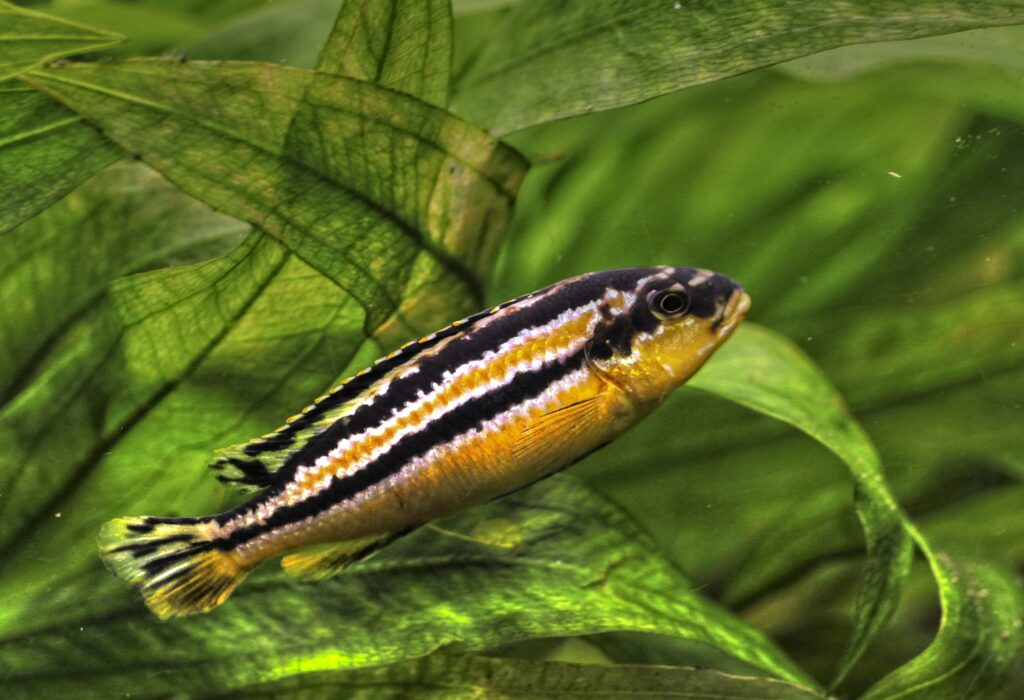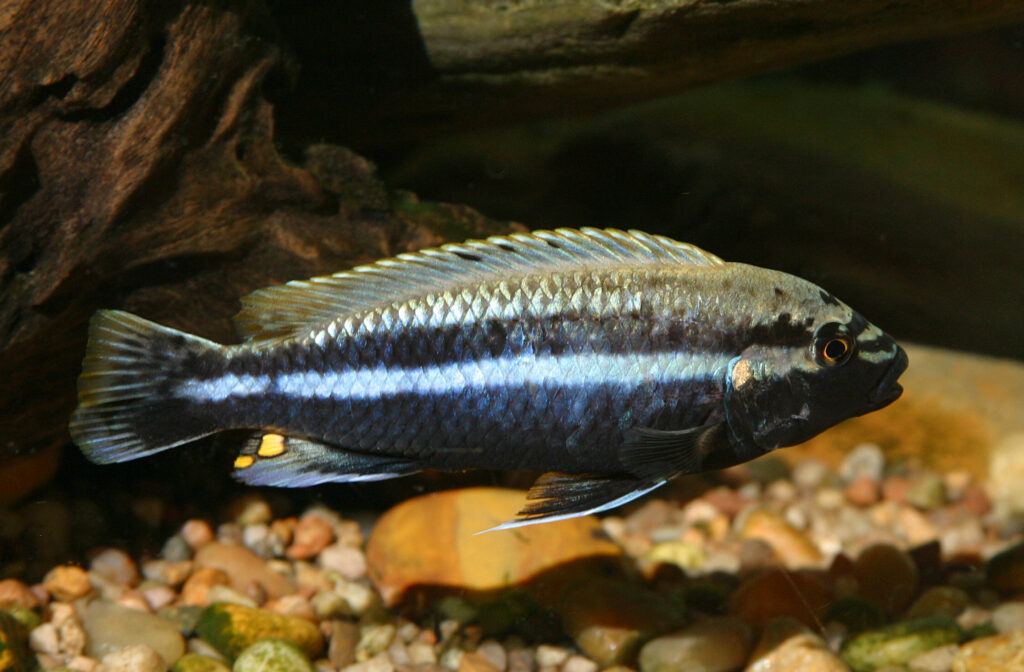Auratus Cichlid
The Auratus Cichlid, melanochromis auratus, famously recognized for its stunning beauty, is a fiercely aggressive species naturally found in the waters of Malawi Lake. A tank teeming with these fishes is a sight to behold, offering an exciting and lively display. However, due to their strongly aggressive behavior, it is typically suggested to keep the Auratus Cichlid in an exclusive species tank with one male and multiple females.
- Experience Level: Intermediate
- Hardiness: Hardy
- Minimum Tank Size: 75 gal (285 L)
- Maximum Size: 4.5 inches (11.5 cm)
- Temperament: Aggressive
- Temperature: 73 – 83° F (23 – 28.5° C)
- pH Range: 7.5 – 8.5
- Water Hardness: 6 – 10 dGH
- Diet: Omnivore
Table of Contents
Introduction
Size and Appearance
Care Guide
Tank Mates
Diet and Feeding
Breeding
Raising a community of this striking African cichlid can be challenging for beginners. Therefore, learn everything about them before you decide to make them a part of your aquarium. The Auratus Cichlid is indigenous to Africa, specifically the Monkey Bay, situated on the west coast of Lake Malawi. They are commonly found in rocky regions and entail closely packed teeth perfectly designed for their dietary habits. They usually feed on zooplankton, insect larvae, snails, aufwuchs, crustaceans, etc.
The Auratus Cichlid is an enchanting freshwater fish from the cichlid family. It’s also known as the Golden Mbuna and Malawi golden cichlid, as it is specifically found in the southern areas of Malawi. The Auratus Cichlid adds a vibrant touch to your aquarium, but raising this fish species can be challenging; hence, it’s not advised for beginners. However, with an adequate understanding, managing an Auratus Cichlid tank is feasible.
Size and Appearance
The Auratus Cichlid, recognized for its yellow color and black horizontal stripes, is easy to distinguish due to its numerous unique features. This fish has an elongated body and carefully spaced teeth akin to incisors, using which they eat algae, biofilm, critters, and other types of fish. They boast a narrow mouth complemented by a rounded snout and exhibit continuous dorsal fins.
On average, an Auratus Cichlid is 4.5 inches (around 12 centimeters). With appropriate care, their size may exceed beyond 4.5 inches. Males are generally larger than females. This species of cichlid is cherished for its mesmerizing colors, which varies between the sexes.
A male Auratus Cichlid is identified by its brown/black body marked with light blue or yellow stripes at the upper part. It also exhibits transparent yellow dorsal fins that run with a thin yellow line horizontally across the body, stretching from the gill to the caudal fin.
Female Auratus Cichlids are fascinating creatures that change their color in the absence of a male. Dominance in females leads to color transitions like that of male Auratus Cichlids. Female Auratus Cichlids, have a vibrant yellow base peppered with black and white stripes at the upper part. Typically, their fins are gold-edged, except for the tail fins featuring a white coloration interspersed with black spots. Females also exhibit black and blue lines running from their eyes down to their caudal fin.
Auratus Cichlids are polygamous, and the presence of a male with numerous females is a common sight. Proper care and optimal aquatic conditions can prolong the lifespan of Auratus Cichlids from an average of 5 years.
Care Guide
- Minimum Tank Size: 75 gal (285 L)
- pH Range: 7.5 – 8.5
- Water Hardness: 7.5 – 8.5 dGH
- Temperature: 73 – 83° F (23 – 28.5° C)
- Lighting: Moderate, diffused lighting
- Substrate: Fine sand/gravel – It will dig up your substrate
- Brackish: No
- Water Flow: Weak/Low
- Tank Region: All areas
Proper attention to caring for your Auratus Cichlid is vital. Appropriate care enhances longevity and wards off common freshwater diseases. To take care of your fish, you must become well-versed with their species-specific needs.
Both male and female Auratus Cichlids are fiercely aggressive, necessitating a large tank. A bigger tank size translates into fewer territorial skirmishes, as they all have sufficient space for retreat and propagation.
Key considerations when setting up an Auratus Cichlid tank should include the following – a tank measuring at least 75 gallons is needed for a single fish. If you’re planning to raise more than one fish, you’ll need a much larger tank, ideally one that can accommodate a minimum of 120 gallons. A larger tank would result in fewer territorial fights between the aggressive Auratus Cichlid and other fishes.
You need to maintain optimal water conditions because any sudden changes can stress the fish, making them more prone to illnesses and eventual death. These are rock-dwelling species; hence, a habitat with ample rocks simulating their natural habitat is essential. Although you may get the idea of adorning the tank with plants, Auratus Cichlids usually uproot all planted decorations.
Tank Mates
Due to their aggressive nature, Auratus Cichlids aren’t ideal for community tank environments. If possible, dedicate a separate tank to these fish. However, if a separate tank isn’t feasible, understanding how the Auratus Cichlids fare with tank-mate compatibility is essential.
Males vastly outnumber females in alleviating aggressive behaviors. Always avoid mixing Auratus Cichlids in the same tank with males from similar-looking species. Even females display aggressive tendencies, with dominant females occasionally killing underpowered males.
Potential tank mates include:
- Yellow lab
- Snow white cichlid
- Kenyi cichlid
- Zebra obliqudens
- Demasoni cichlid
In small tanks or aquariums, cohabiting two males can lead to disastrous outcomes. However, if the tank size permits, adding additional male Auratus Cichlids can be considered.
Feeding Guide
- Diet: Omnivore
- Frequency: Several small feedings per day
- Pellet Foods: Yes
- Flake Foods: Yes
- Live Foods: Yes
- Meat Foods: Yes
- Vegetable Foods: Yes
Auratus Cichlids primarily follow an omnivorous diet, leaning more towards herbivorous feeding habits. Common food choices include food flakes, pellets, leafy greens, meat, diatoms, fishes, shrimps, worms, etc. Remember to provide them with food rich in quality, as a lack of proper feeding can expose them to risks of Malawi bloat – a disease commonly contracted by Auratus Cichlids. It’s better to provide them with small meals several times throughout the day than to overload them with a large meal at once. A feeding portion that they can finish within 3 minutes is the optimal way to avoid overfeeding and the stress associated with it.
Breeding
Breeding Auratus Cichlids is relatively straightforward. Providing them with favorable conditions, especially at higher temperature ranges, can effectively encourage breeding. Increased aggression and intensified substrate digging by males are common signs of impending breeding activities.
Typically, the male commences the mating process by creating a nest in the sand and warding off any other fish approaching the designated breeding spot. The male starts to circulate around the female, who lays the eggs and collects them in her mouth. Auratus Cichlids are known to be mouth breeders. Subsequently, the male fertilizes the eggs while they’re still in the female’s mouth.
The number of eggs a female Auratus Cichlid lays is largely determined by the size of the female. However, on average, a female can yield anywhere between 10 to 40 eggs. Hatching takes around three weeks, during which the female starves, housing the eggs inside her mouth. To prevent women from starving, many breeders transfer the eggs from the females into an incubator to facilitate hatching.
Upon incubation, free-swimming fry evolve, which are initially taken care of by the female for several days.
Post-hatching, it’s advisable to provide the young ones a separate tank for growth and maturation to avoid potential parent-fry conflicts once the next breeding season commences.
The fry’s diet primarily mirrors that of an adult Auratus Cichlid’s, consisting of finely powdered food, leafy greens, and brine shrimp nauplii. Be sure to offer them small meal portions that they can complete in under 3 minutes and maintain regular feeding intervals.



